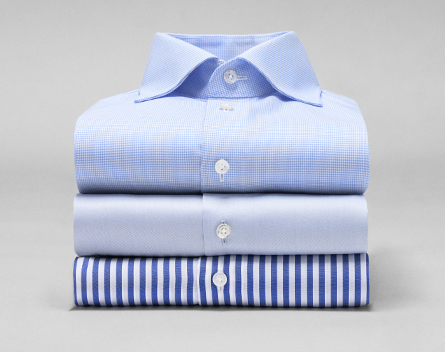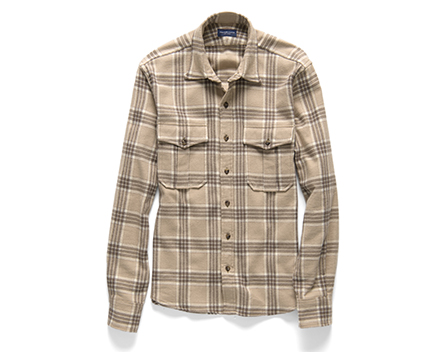At Proper Cloth, we offer a wide range of shirt styles, and depending on the type of fabric used for the shirt, the care instructions will be different. Washing your shirt according to the suggested care instructions will help ensure that the shirt lasts a long time and will look its best.
Furthermore, we adjust each shirt for shrinkage differently, with the goal of the shirt matching your ordered dimensions plus standard allowances after 1-2 washes. Washing your shirt according to the suggested care instructions helps ensure that it will fit you consistently with your other shirts (and the way you want).
Overall we have six different sets of care instructions for each of these types of shirts: Dress Shirts, Non-Iron Shirts, Casual Shirts, Knit Shirts, Performance Shirts, and Dry Clean Shirts.
Dress Shirt Care Instructions
Your shirt tag will say “Machine Wash, Non-Chlorine Bleach, Hang Dry, Iron“

- Prepare the dress shirt by unbuttoning all of the buttons, including cuff and collar buttons. Remove any collar stays and put them in a safe place.
- Pre-treat any stains by carefully working a little detergent into them or spot-cleaning with a stain remover pen.
- Set up your washing machine: To minimize wear on a fine or lightweight dress shirt, use the Delicate cycle. If the shirt is made from a heavier fabric, or is particularly dirty, you may opt for the Normal cycle. Whites can use warm or hot water. Colored shirts should use cold water to reduce fading. Take care not to include other laundry items with bold colors that could bleed onto your shirts.
- Use a high-quality detergent, that is appropriate for the color of the shirt. Do not use chlorine-based detergents or bleaches as these can discolor your shirts.
- Wash the shirts in the washing machine and let the spin cycle wring most of the water out of them.
- The shirts will be tightly crumpled in the washing machine so remove them promptly before wrinkles dry into the shirt.
- Lightly shake the shirts to remove wrinkles and hang the shirts on a hanger so they can air dry. Button the top-button only on the shirt as it hangs. Standard wire hangers are fine, but avoid using tight clothespins as these can distort the shirt fabric or leave a mark on the shirt.
- Next you’ll want to iron the shirts. You don’t need to wait for the shirts to be completely dry to begin this step, but they should be mostly dry.
- Put each dress shirt on a hanger, reinsert collar stays if you choose to use them and button the top button of each shirt. Ensure the collar is in a good position, and the collar points are not rolling under the collar.
- Store dress shirts hanging on shirt hangers with the top button buttoned.
Casual Shirt Care Instructions
Your shirt tag will say “Machine Wash, Non-Chlorine Bleach, Hang Dry“

- Prepare the casual shirt by unbuttoning all of the buttons, including cuff and collar buttons. Remove any collar stays and put them in a safe place.
- Pre-treat any stains by carefully working a little detergent into them or spot-cleaning with a stain remover pen.
- Set up your washing machine: To minimize wear on a fine or lightweight dress shirt, use the Delicate cycle. If the shirt is made from a heavier fabric or is particularly dirty, you may opt for the Normal cycle. Whites can use warm or hot water. Colored shirts should use cold water to reduce fading. Take care not to include other laundry items with bold colors that could bleed onto your shirts. Similarly, some casual shirts use natural dyes that can bleed onto your other items, so be sure to only wash casual shirts with like colors.
- Use a high-quality detergent, that is appropriate for the color of the shirt. Do not use chlorine-based detergents or bleaches as these can discolor your shirts.
- Wash the shirts in the washing machine, and let the spin cycle wring most of the water out of them. The shirts will be tightly crumpled in the washing machine so remove them promptly before wrinkles dry into the shirt.
- Lightly shake them out to remove wrinkles and hang the shirts on a hanger so they can air dry. Standard wire hangers are fine, but avoid using tight clothespins as these can distort the shirt fabric or leave a mark on the shirt. Button the top button of the shirt as it hangs and fluff or bat the shirt to remove as many wrinkles or folds as possible.
- Shape the damp collar into a nice shape, ensuring the collar points are not rolling under. Make sure the shirt tails are not rolling up. Make sure the inside of a French front is not twisted or folded back on the inside of the shirt. For a Camp collar, only button the third button down (or whichever button you will button when you wear the shirt), and fold the collar back smoothly.
- After the shirt is dry it is ready to wear. You can touch-up iron or steam it if you want, but most small wrinkles will work themselves out after you put the shirt on.
- Store casual shirts hanging on shirt hangers with the top button buttoned or lightly folded and stacked.
Knit Shirt Care Instructions
Your shirt tag will say “Machine Wash, Non-Chlorine Bleach, Machine Dry Low“

- Prepare the knit shirt by unbuttoning all of the buttons, including cuff and collar buttons. Remove any collar stays and put them in a safe place.
- Pre-treat any stains by carefully working a little detergent into them or spot-cleaning with a stain remover pen.
- Set up your washing machine: To minimize wear, use the delicate cycle. Whites and very light colors can use warm water. Darker-colored knit shirts that you don’t want to fade should use cold water. Take care not to include other laundry items with bold colors that could bleed onto your shirts.
- Use a high-quality detergent, that is appropriate for the color of the shirt. Do not use chlorine-based detergents or bleaches as these can discolor some shirt fabrics.
- Wash the knit shirts in the washing machine, and then let the spin cycle wring most of the water out of them.
- Dry the knit shirts in a machine dryer on a Low setting.
- Promptly remove the shirts from the dryer. Fluff and bat them to remove major wrinkles. Put the collar in a nice position and fold the shirts carefully.
- If necessary use a light iron to further smooth out wrinkles on the body or sharpen the collar. Take special care when ironing the sleeves or body as this can cause them to elongate.
- Button the top button and leave the collar sticking up straight, or in a position where it can lay flat naturally.
- Store knit shirts lightly folded and stacked. Avoid storing knit shirts on hangers as this will cause the sleeves and body of the shirts to elongate over time.
Non-Iron Shirt Care Instructions
Your shirt tag will say “Machine Wash, Non-Chlorine Bleach, Machine Dry“
- Prepare the non-iron shirt by unbuttoning all of the buttons, including cuff and collar buttons. Remove any collar stays and put them in a safe place.
- Pre-treat any stains by carefully working a little detergent into them or spot-cleaning with a stain remover pen.
- Set up your washing machine: To minimize wear on a lightweight non-iron shirt, use the Delicate cycle. If the shirt is made from a heavier fabric, or is particularly dirty, you may opt for the Normal cycle. Whites can use warm or hot water. Colored shirts should use cold water to reduce fading. Take care not to include other laundry items with bold colors that could bleed onto your shirts.
- Use a high-quality detergent, that is appropriate for the color of the shirt. Do not use chlorine-based detergents or bleaches as these can discolor your shirts.
- Wash the non-iron shirts in the washing machine and let the spin cycle wring most of the water out of them. Remove promptly.
- Dry the non-iron shirts in a machine dryer on the Low setting. *Note: Non-Iron shirts are designed to be dried in a machine dryer, and it is this process that helps remove the wrinkles from the shirt.
- Promptly remove the shirts from the dryer. Shake the shirts a bit to help the fabrics return to their natural smooth shape and hang on hangers.
- Reinsert collar stays if you choose to use them and button the top button of each shirt. Ensure the collar is in a good position, and the collar points are not rolling under the collar.
- Store non-iron shirts hanging on shirt hangers.
Performance Shirt Care Instructions
Your shirt tag will say “Machine Wash, Non-Chl Bleach, Machine Dry, No Iron“
- Prepare the performance shirt by unbuttoning all of the buttons, including cuff and collar buttons. Remove any collar stays and put them in a safe place.
- Pre-treat any stains by carefully working a little detergent into them or spot-cleaning with a stain remover pen.
- Set up your washing machine: To minimize wear use the Delicate cycle. If the shirt is made from a heavier fabric, or is particularly dirty, you may opt for the Normal cycle. White performance shirts should use warm water. Colored performance shirts should use cold water. Take care not to include other laundry items with bold colors that could bleed onto your shirts.
- Use a high-quality detergent, that is appropriate for the color and material of the shirt. Do not use chlorine-based detergents or bleaches as these can discolor your shirts.
- Wash the shirts in the washing machine, and let the spin cycle wring most of the water out of them.
- Dry the performance shirts in a machine dryer on a Low setting.
- Promptly remove the shirts from the dryer. Fluff and bat them to remove major wrinkles. Put the collar in a nice position and fold the shirts carefully.
- Store performance shirts lightly folded and stacked. Avoid storing performance knit shirts on hangers as this will cause the sleeves and body of the shirts to elongate over time. Performance woven shirts can be stored hanging on hangers.
- Do not attempt to iron or steam a performance shirt. Performance shirts use materials that can melt or become permanently distorted when subject to high heat!
- Store performance shirts hanging on shirt hangers with the top button buttoned or lightly folded and stacked.
Professional Dry Clean Care Instructions
Your shirt tag will say “Professionally Dry Clean“
We rarely suggest a shirt be dry cleaned, but occasionally it’s necessary. Typically this care method is reserved for shirts made from a particularly fine or rare material that is sensitive to intense heat or that should not be wet.
In some cases, we will recommend this care method for knit shirts that are known to have particularly high shrinkage if they are washed with water.